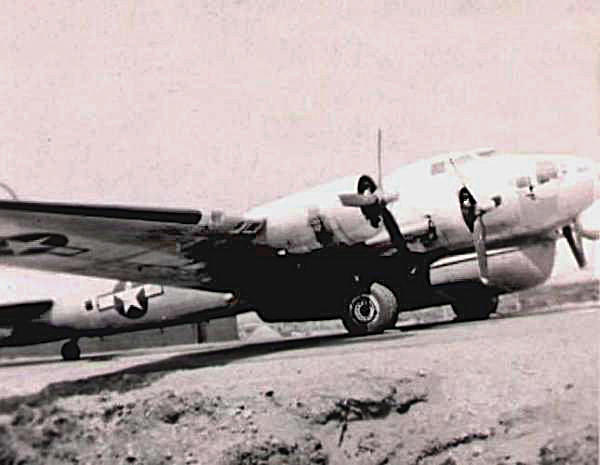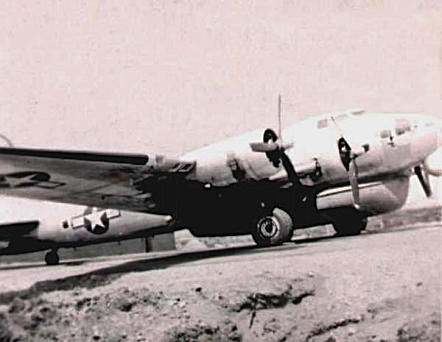

The Aleutians

The Lands of 50 mph Fog
© HLSWILLIWAW.COM
Built with XARA
B-17

This photo of an Aleutian SB-17, outfitted as a rescue plane, was seen on Shemya around
1945-46. Provided by Dan Lange. Many thanks for this rare shot!
First flown on 28 July 1935, the B-17 prototype known as the Boeing 299, was immediately dubbed the "Flying Fortress" by the
press corps in attendance. The USAAC ordered 13 YB-17s, followed by another contract for 39 near-identical B-17Bs. By the
middle of the 1940s, the Fortress had been further improved with the addition of two extra guns and more powerful engines.
Twenty B-17Cs were exported to Britain to serve with the RAF. Early lessons learned in Europe resulted in Boeing enhancing
the armor of future models, along with additional guns and self-sealing fuel tanks. This resulted in the B-17E, 512 of which were
built in 1941 and 1942. These were followed by the B-17F, which had a re-designed nose to incorporate a 0.50-in gun, a
strengthened undercarriage to cope with increased bomb loads, and Wright R-1820-97 engines. The final version was known as
the B-17G, of which 8,680 were built. It had a gun turret located in the front and bottom of the aircraft. There was an SB-17, a
Fortress converted for search and rescue duty that saw service in the Aleutians. The key to the B-17's design and success was
this heavy machine gun armament that enabled the B-17 to penetrate defended airspace unescorted. There were 12,731 B-17s
built by Boeing, Douglas, and Lockheed.
There were few B-17 pilots over the age of 30, with most of their crews consisting of men only in their 20's. The first American
combat loss in WWII was that of a B-17 shot down by Japanese Zeroes on the way to Pearl Harbor. The B-17 fought in every
theater of WWII. While it was America's main strategic weapon in Europe, it also saw action in the Aleutians.
Specifications:
First Flight Date: 28 July 1935
Type: Nine/10-seat long-range bomber.
Powerplant: Four 1,200-hp Wright R-1820-97 Cyclone turbocharged radial piston engines.
Maximum speed: 287 mph at 25,000 ft.
Ceiling: 35,600 ft.
Range: 2,000 miles with 5,000 lb bomb load.
Weights: Empty 36,135 lbs; Max (Take-off) 65,500 lbs.
Weapons: 13 ea. 50 caliber machine guns in twin turrets, plus single dorsal and fore and aft beam positions; 17,600 lb max
bomb load.
Dimensions:
Span: 103 ft 9 in
Wing Area: Approx 1,420 sq. ft.
Length: 74 ft 4 in
Height: 19 ft 1 in
Additional References: 1) Jane's Historic Military Aircraft 2) Aircraft of the World



The Aleutians

The Lands of 50 mph Fog
B-17

This photo of an Aleutian SB-17, outfitted as a rescue plane, was seen on Shemya around
1945-46. Provided by Dan Lange. Many thanks for this rare shot!
First flown on 28 July 1935, the B-17 prototype known as the
Boeing 299, was immediately dubbed the "Flying Fortress" by the
press corps in attendance. The USAAC ordered 13 YB-17s,
followed by another contract for 39 near-identical B-17Bs. By the
middle of the 1940s, the Fortress had been further improved with
the addition of two extra guns and more powerful engines. Twenty
B-17Cs were exported to Britain to serve with the RAF. Early
lessons learned in Europe resulted in Boeing enhancing the
armor of future models, along with additional guns and self-
sealing fuel tanks. This resulted in the B-17E, 512 of which were
built in 1941 and 1942. These were followed by the B-17F, which
had a re-designed nose to incorporate a 0.50-in gun, a
strengthened undercarriage to cope with increased bomb loads,
and Wright R-1820-97 engines. The final version was known as the
B-17G, of which 8,680 were built. It had a gun turret located in the
front and bottom of the aircraft. There was an SB-17, a Fortress
converted for search and rescue duty that saw service in the
Aleutians. The key to the B-17's design and success was this
heavy machine gun armament that enabled the B-17 to penetrate
defended airspace unescorted. There were 12,731 B-17s built by
Boeing, Douglas, and Lockheed.
There were few B-17 pilots over the age of 30, with most of their
crews consisting of men only in their 20's. The first American
combat loss in WWII was that of a B-17 shot down by Japanese
Zeroes on the way to Pearl Harbor. The B-17 fought in every
theater of WWII. While it was America's main strategic weapon in
Europe, it also saw action in the Aleutians.
Specifications:
First Flight Date: 28 July 1935
Type: Nine/10-seat long-range bomber.
Powerplant: Four 1,200-hp Wright R-1820-97 Cyclone
turbocharged radial piston engines.
Maximum speed: 287 mph at 25,000 ft.
Ceiling: 35,600 ft.
Range: 2,000 miles with 5,000 lb bomb load.
Weights: Empty 36,135 lbs; Max (Take-off) 65,500 lbs.
Weapons: 13 ea. 50 caliber machine guns in twin turrets, plus
single dorsal and fore and aft beam positions; 17,600 lb max
bomb load.
Dimensions:
Span: 103 ft 9 in
Wing Area: Approx 1,420 sq. ft.
Length: 74 ft 4 in
Height: 19 ft 1 in
Additional References: 1) Jane's Historic Military Aircraft 2)
Aircraft of the World
© HLSWILLIWAW.COM
Built with XARA

















